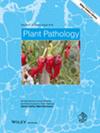Morphology, phylogeny and pathogenicity of fungal species associated with leaf blight and stem canker of Theobroma cacao in Malaysia
IF 2.4
3区 农林科学
Q1 AGRONOMY
引用次数: 0
Abstract
Malaysia stands prominently among Asia's key cocoa-producing countries. In the cocoa season of 2022–2023, Malaysia demonstrated its contribution to the industry, with an estimated production of around 364,000 tonnes of cacao bean grindings. Nonetheless, fungal diseases pose undeniable challenges to the cocoa sector. Extensive sampling conducted between September 2018 and March 2019 across multiple states in Malaysia revealed concerning symptoms of leaf blight and stem canker affecting Theobroma cacao plants. The aim of this study was to identify and characterize fungal species associated with leaf blight and stem canker of T. cacao in Malaysia through morphological, molecular and pathogenicity analyses. Morphological and molecular phylogenetic analyses using multiple DNA regions (rDNA internal transcribed spacer [ITS], TEF1 and TUB2) were performed and identified 40 fungal isolates found in this study as Diaporthe tulliensis (17 isolates), Fusarium solani (seven isolates), Fusarium proliferatum (six isolates) and Neopestalotiopsis clavispora (10 isolates). Pathogenicity tests with mycelial plugs and wound treatments showed that D. tulliensis and N. clavispora were responsible for causing leaf blight whereas D. tulliensis, F. solani and F. proliferatum caused stem canker of T. cacao. The present study provides insights into disease aetiology and symptomatology that may be useful in planning effective disease management for the host plant.

马来西亚可可树叶枯病和茎腐病相关真菌种类的形态、系统发育和致病性
马来西亚是亚洲主要的可可生产国之一。在2022-2023年的可可生产季节,马来西亚预计将生产约36.4万吨可可豆碾碎物,显示了其对可可业的贡献。然而,真菌疾病对可可行业构成了不可否认的挑战。2018 年 9 月至 2019 年 3 月期间,在马来西亚多个州进行的广泛采样揭示了影响可可树植物的叶枯病和茎腐病的相关症状。本研究旨在通过形态学、分子和致病性分析,鉴定与马来西亚可可叶枯病和茎腐病相关的真菌物种并确定其特征。利用多个 DNA 区域(rDNA 内部转录间隔区 [ITS]、TEF1 和 TUB2)进行了形态学和分子系统学分析,确定了本研究中发现的 40 个真菌分离物为 Diaporthe tulliensis(17 个分离物)、Fusarium solani(7 个分离物)、Fusarium proliferatum(6 个分离物)和 Neopestalotiopsis clavispora(10 个分离物)。用菌丝塞和伤口处理进行的致病性测试表明,D. tulliensis 和 N. clavispora 是造成叶枯病的罪魁祸首,而 D. tulliensis、F. solani 和 F. proliferatum 则是造成可可茎腐病的罪魁祸首。本研究提供了有关病害病原学和症状学的见解,可能有助于为寄主植物规划有效的病害管理。
本文章由计算机程序翻译,如有差异,请以英文原文为准。
求助全文
约1分钟内获得全文
求助全文
来源期刊

Plant Pathology
生物-农艺学
CiteScore
5.60
自引率
7.40%
发文量
147
审稿时长
3 months
期刊介绍:
This international journal, owned and edited by the British Society for Plant Pathology, covers all aspects of plant pathology and reaches subscribers in 80 countries. Top quality original research papers and critical reviews from around the world cover: diseases of temperate and tropical plants caused by fungi, bacteria, viruses, phytoplasmas and nematodes; physiological, biochemical, molecular, ecological, genetic and economic aspects of plant pathology; disease epidemiology and modelling; disease appraisal and crop loss assessment; and plant disease control and disease-related crop management.
 求助内容:
求助内容: 应助结果提醒方式:
应助结果提醒方式:


